20+ Foods to Avoid with Dysphagia (What to Eat Instead)
Dysphagia occurs when it is difficult to swallow and can be caused by a variety of reasons. In this article, we’ll review the foods to avoid with dysphagia and what to eat instead. Following a dysphagia diet can help ensure you meet your nutritional needs without the risk of choking.

Overview of Dysphagia
Dysphagia is the term used to describe difficulty in swallowing.
Swallowing problems are more common than you might think, with around 1 in 25 adults experiencing cases of dysphagia every year.
Sometimes, people are not able to swallow at all. But it’s more common for people with dysphagia to experience problems only with certain foods and drinks.
There are lots of different things that can cause dysphagia, including stroke, brain injury, head and neck problems, cerebral palsy, metabolic issues like hyperthyroidism, and certain infectious diseases.
The condition can even be a side effect of taking some medications.
The symptoms of dysphagia include:
- The presence of food or drink in the mouth, even after swallowing
- Drooling and difficulty managing saliva
- Taking a long time to chew and swallow solid food
- A feeling of fullness in the neck
- Difficulty in keeping the lips closed
- Voice changes and/or coughing while eating or drinking (or just after)
Dysphagia is inconvenient, sometimes provoking feelings of embarrassment around others and making some social situations a challenge.
But it can be dangerous, too, potentially leading to dehydration or malnutrition. Another risk is aspiration pneumonia – an infection of the lungs caused by breathing food or liquid into the airways instead of swallowing it.
Foods to Avoid with Dysphagia
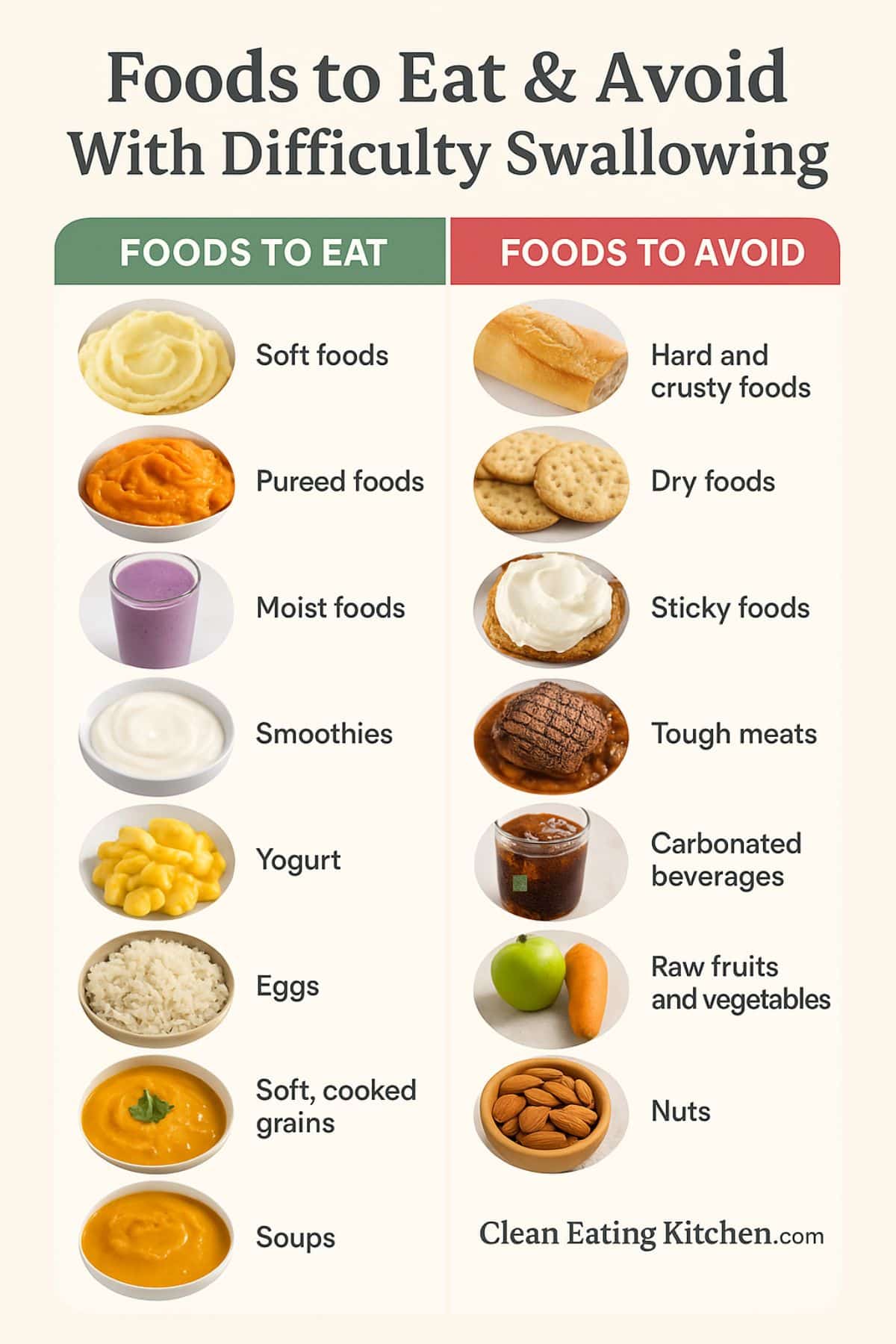
1. Hard and Crunchy Foods
Foods with a dense or crunchy texture can be tough to chew and difficult to swallow.
These include nuts, chips, crackers, and cookies.
2. Dry Foods
Without anything to moisten them, dry foods can be very challenging to swallow.
Avoid things like dry cereal, crispy fries, dry crackers, and dry bread that can be harder for the throat muscles to handle.
3. Sticky Foods
Some sticky foods can be difficult for anyone to swallow as they tend to stick to the roof of the mouth, so they’re particularly problematic if you suffer from dysphagia.
Avoid things like caramel, taffy, dried fruits, marshmallows, cream cheese, or soft cheeses like Brie. The sticky consistency of these foods is harder to manage.
4. Tough Meats
Certain types of meat – especially beef steaks and cuts of pork – can be very tough to chew and swallow.
Unless pureed or prepared in a way that increases their moisture content, avoid these meats altogether.
It’s also important to avoid the skin on meat, which can be especially hard to swallow.
Ground meat may be easier to chew and swallow.
5. Spicy Foods
Spicy foods tend to contain capsaicin, an irritant that can cause a burning sensation in any tissue with which it comes into contact.
This explains the discomfort that many people experience after eating foods like curry.
This can worsen any swallowing difficulties you might have but it can also trigger acid reflux, compounding the problem even further.
6. Carbonated Beverages
Some experts recommend avoiding carbonated beverages if you have dysphagia because they may cause discomfort, or because they may need thickening in order to be consumed safely.
But I’d recommend speaking to your healthcare provider for clarification, as new research suggests that thickened carbonated drinks positively affect swallowing compared with thickened non-carbonated drinks.
This means they could actually be helpful for certain people with dysphagia.
7. Alcohol
There are several problems associated with alcohol for people with dysphagia.
- Drinking too much alcohol may actually trigger dysphagia.
- Alcoholic drinks are too thin in texture for many people to consume safely.
- Drinking alcohol may trigger the symptoms of GERD (gastroesophageal reflux disease), making swallowing problems worse.
8. Bread with Hard Crusts
Unless it’s soaked in some sort of liquid, most bread can be tough to swallow for someone with dysphagia.
Hard crusts can make the problem even worse, so be sure to avoid foods like baguettes and crusty artisan loaves.
9. Raw Fruits and Vegetables
Raw vegetables and certain fresh fruits – particularly apples, celery, and carrots – can be problematic because they have a hard texture and are difficult to chew.
Blackberries and raspberries should also be avoided, as they are packed with hard seeds.
Many experts recommend avoiding watermelon, too, because it is classed as a “mixed consistency” food.
This means that – when you bite into it – liquid leaks out and you then have two consistencies in your mouth. This is something many people with dysphagia find challenging.
In order to consume fruits and vegetables as part of a balanced diet, consider smoothies made with a high-speed blender like a Vitamix.
See my whole list of delicious and nutritious smoothies that may help with achieving good nutrition even with a modified diet.
10. Popcorn
Popcorn is notoriously difficult to swallow and can very easily become lodged in the throat, posing a choking hazard.
11. Tough or Chewy Candies
Just like the “sticky foods” mentioned above, certain candies can easily become stuck to the roof of your mouth and are hard to get down.
Avoid these while dealing with any type of dysphagia.
12. Chunky or Creamy Peanut Butter
Both chunky and smooth peanut butter can be hazardous if you have dysphagia.
The chunky variety has pieces of peanut that can easily become lodged in your throat, and – just like smooth peanut butter – it has a sticky texture that can be very tough to swallow.
13. Seeds and Nuts
Seeds are nuts are simply too hard to chew and swallow safely.
This means that they present a serious choking hazard and should be avoided completely.
14. Tough or Stringy Vegetables or Fruits
Even when cooked, certain fruits and vegetables have a tough, stringy, or fibrous texture that can make them extremely difficult to swallow.
Pineapple is one of the worst offenders, with both the fresh and canned varieties being difficult to manage.
Others to avoid include corn, peas, asparagus, broccoli, celery, and green beans.
15. Grapes
Grapes are difficult to chew and swallow because their skins are relatively tough and thick. Their shape also makes them a potential choking hazard.
16. Thick or Sticky Sauces
While some sauces can be helpful in moistening dry foods and making them easier to swallow, if they are particularly thick or sticky they may actually make things worse.
It’s important that any sauces you consume are of a texture recommended by your healthcare provider, as this is determined based on your level of dysphagia.
17. Hot or Cold Foods
When it comes to temperature, the best way to avoid problems is to serve foods that are cool or warm, as opposed to very cold or very hot.
Extremes of temperature can make swallowing difficulties worse.
18. Hard Candy
Like any hard foods, hard candy can be difficult to chew properly and may easily become lodged in the throat.
19. Raw Leafy Greens
Raw leafy greens and other veggies that might seem soft but have a “floppy texture” should be avoided, as they can be very hard to swallow.
Examples include raw spinach leaves, kale, lettuce, and cucumber.
20. Ice
Experts recommend avoiding ice if you have dysphagia because it very quickly melts in the mouth, turning into an unthickened liquid.
This increases the risk of aspiration and potential infection in the lungs.
Foods to Enjoy with Dysphagia
This list is meant to serve as a general guideline for people with dysphagia but I recommend double-checking with your doctor or healthcare professional before eating these foods.
That’s because everyone’s needs are different and some of these foods may be more suitable for you than others, especially if you require thickened fluids.
1. Soft Foods
There are lots of delicious soft foods that you can enjoy on a dysphagia diet, with plenty of savory and sweet options!
Cooked vegetables (with the exception of the stringy foods mentioned above) are ideal. Test them with a fork to make sure they are soft enough and cut them into dice less than ½ inch in size before serving.
You can also enjoy tofu, mashed potato, tender meats (especially when slow-cooked until they practically melt in your mouth), and even tuna or egg salads. Just make sure they don’t contain any hard bits (like chunks of celery or onion).
For dessert, you can indulge in treats like applesauce, pudding, custard, and Jello.
If your doctor has recommended avoiding ice cream because of an issue with dual consistencies, try freezing then pureeing a banana for a healthy ice cream alternative.
It doesn’t melt in the same way as regular ice cream and may be easier to manage.
2. Pureed Foods
The good news is that you can puree almost all foods to just the right texture, as long as you mix them with a suitable liquid and have a powerful food processor or blender.
The exception would be particularly fibrous or stringy foods. These don’t blend well and would need straining before serving.
Try to avoid using water as a liquid for pureeing. It will simply dilute your ingredients and produce a dish that tastes less than appealing!
Instead, use a delicious gravy for meat, or perhaps a light and creamy sauce for fish.
To make foods easier to puree, try cooking them with moisture (steaming, poaching, stewing, etc) rather than cooking them with dry heat.
Meat or fish tend to be easier to puree when cooked in either tomato soup or tomato juice.
See my related full list of the best soft foods.
3. Moist Foods
Moisture is key when it comes to making foods easier to swallow, so choosing moist foods – or adding moisture – is ideal if you have dysphagia.
Good examples of moist foods include stews, casseroles, and very well-cooked pasta in a sauce (macaroni and cheese, for example).
Foods to which you can add moisture include certain types of cereal (moistened with milk), French toast or pancakes well moistened with syrup or applesauce, and finely diced meat, poultry, or fish served with gravy.
4. Smoothies and Milkshakes
Not only do smoothies and milkshakes tend to have an ideal texture for people with dysphagia, but they are a convenient way to pack in a lot of important nutrients!
If, for example, your dysphagia means you eat very little meat and your protein intake is low, you can add protein sources such as nuts, protein powders, yogurt, and more for a welcome boost.
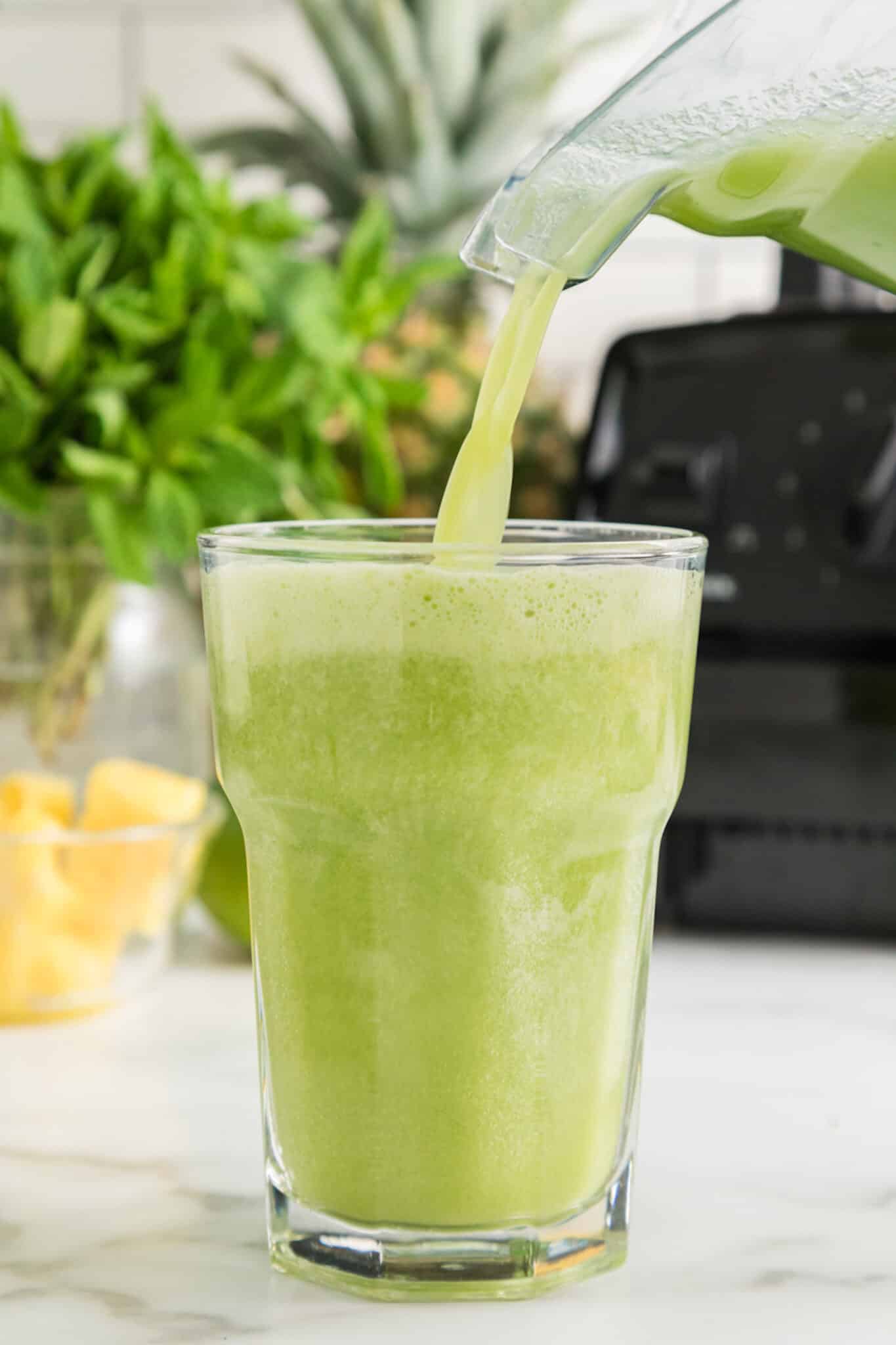
5. Yogurt
High in protein and rich in probiotics, yogurt is a healthy food with a creamy, easy-to-eat texture.
Just remember that not all yogurt is healthy – some brands are loaded with sugars and flavorings that may wipe out their health benefits!
The best option is to buy plain, unflavored yogurt, then sweeten it yourself with your favorite fresh fruit. Pureed bananas or strawberries are ideal, as they have a naturally sweet flavor.
6. Eggs
Eggs are another excellent source of protein and there are lots of ways you can prepare them that make them easy to swallow.
Poaching, soft-boiling, and scrambling are all great methods, although you need to be careful when scrambling eggs in order to keep them soft enough.
A good tip is to prepare them in the top of a double boiler instead of in a pan.
Try scrambling eggs with cheese, which adds some variety and flavor!
Depending on the severity of your dysphagia you may also be able to enjoy a deliciously light souffle.
7. Soft, Cooked Grains
Grains like oatmeal, rice, and barley – plus pseudo-grains like quinoa and amaranth – contain lots of important nutrients.
In order to make them easier to swallow, cook them thoroughly and serve them in a sauce or gravy. You can also add them to your soups and casseroles.
Although slightly less nutritious, white rice tends to cook to a softer texture than brown.
8. Soups
Soups make ideal meals if you find swallowing difficult and are easy to tailor to your preferences!
Avoid making soups that are too thin, as these may pose an aspiration hazard, and make sure they don’t contain any large chunks of meat, vegetables, or other ingredients.
9. Mashed or Pureed Beans
Rich in protein and fiber, beans are a great source of nutrition. However, they tend to have tough skins that can make them hard to swallow.
The solution is to eat them pureed or mashed – as with hummus or refried beans. You can also enjoy baked beans, which are not only soft but have the added benefit of being served in a sauce
10. Soft, Ripe Fruits
Fruits provide a whole spectrum of vitamins and minerals along with the dietary fiber you need for good digestion.
While stringy fruits like pineapple may be off the menu, there are still lots of other options to enjoy, including soft, ripe bananas, peaches, and cantaloupe (with all skins and membranes removed).
For even more variety, you can include canned fruits, as these tend to be easier to mash than raw fruits. Just be sure that they don’t contain any seeds or skin.
Don’t forget to add suitable fruits to your smoothies and yogurts, too!
Dysphagia Diet
If you suffer from dysphagia, then your healthcare provider will probably have already spoken to you about some of the changes you may need to make to your diet in order to make eating and drinking as safe as possible.
A dysphagia diet consists of foods that you can chew and move around your mouth easily. This will help minimize the risk of them going the wrong way and potentially being aspirated into your lungs. Dysphagia-appropriate types of foods can also help reduce difficulty of swallowing.
A balanced dysphagia diet should also contain foods from a variety of food groups, so your body gets all the nutrients it needs.
Your healthcare provider is the best person to give you specific advice, as dysphagia isn’t the same for everyone.
Besides a doctor or clinical professional, a speech-language pathologist, speech therapist, or language therapist may also have tips on texture-modified diets that may help with difficulty swallowing. Other types of healthcare professionals may be trained in this as well, such as registered dietitians.
But there are a few tips for following a dysphagia diet that you may find useful:
- Try to eat little and often, which can be less overwhelming than trying to consume a larger meal. Try to eat small bites at a time.
- Add tasty sauces or gravies to the foods you are allowed to consume in order to make them easier to manage… and a lot more tempting!
- There’s a well-known saying that “we eat first with our eyes” – so work on making foods as visually appealing as possible to prevent unwanted weight loss.
- Try to sit at a 90-degree angle while eating, supported by pillows if necessary.
You might also like to speak to your health care provider about including liquid nutrition supplements like smoothies or prepared protein drinks in your diet if you’re worried you may not be consuming enough calories or protein.
These may need to be thickened to the texture that’s right for you. Sometimes thin liquids may be even harder to swallow than thickened liquids, despite the smooth texture.
My Experience
I experienced dysphagia off and on for several years after my thyroid cancer surgery. This was likely due to scar tissue in my neck around where my thyroid and lymph nodes were removed.
While my swallowing has gotten easier, I still have to be careful not to talk and swallow at the same time. I also try to chew my food thoroughly which makes swallowing easier and makes me feel more confident that I won’t choke.
But, I understand how difficult it can be and I hope this article is helpful for others experiencing signs of dysphagia.
More Health Resources You Might Like
Summary
The thought of adjusting to a dysphagia diet may be daunting, but the good news is that there are still many wonderfully tasty and nutritious foods you can enjoy on a daily basis.
You may need to put a little more thought into your meals and adapt your preparation methods, but by doing that you can create a varied, appealing menu and look forward to mealtimes once again.
Don’t forget to join my newsletter list to get exclusive clean eating recipes and tips. The newsletter is 100% free with no spam; unsubscribe anytime.
About the Author: Carrie Forrest has a master’s degree in public health with a specialty in nutrition and is a certified holistic nutritionist. She is a top wellness and food blogger with over 5 million annual visitors to her site. Carrie has an incredible story of recovery from chronic illness and is passionate about helping other women transform their health. Send her a message through her contact form.
Note: this post is for informational purposes only and is not intended as medical advice. Please consult your healthcare provider for recommendations related to your individual situation.




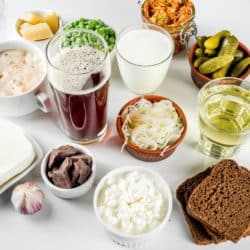
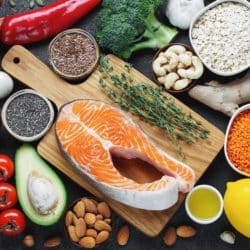
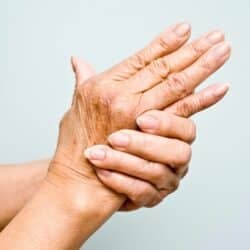


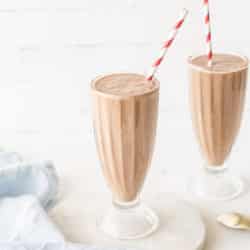


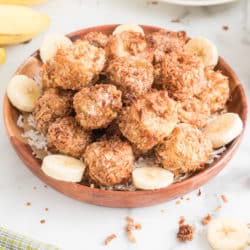







This was a very helpful article. I am a volunteer with a hospice group and one of the people I visit has dysphagia. I asked her if there was something she might like me to bring for her when I visit and she asked for flavored soda and Reeses. Both are on the bad list. I am thinking perhaps some tasty yogurt instead. She doesn’t get many visitors and is a younger patient than I usually visit. My guess is she has ALS. It is difficult trying to get answers from the staff which is why I am did some online research.
I’m so glad that the article was helpful! And I’m sorry about your patient…I also have a friend with ALS and it is very sad.